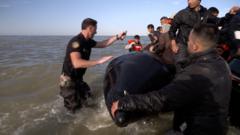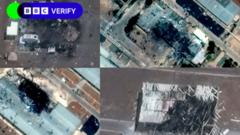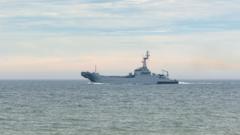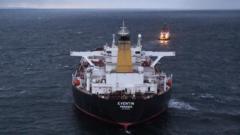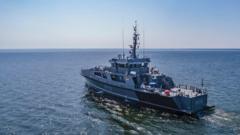A BBC Verify investigation uncovers that the Russian corvette 'Boikiy' disguised itself with a fake ID while escorting sanctioned oil tankers through the English Channel, prompting questions about military involvement in protecting Russian shipping operations.
Russian Warship Employs Deceptive Tactics While Navigating English Channel
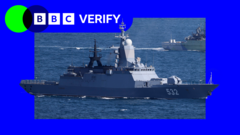
Russian Warship Employs Deceptive Tactics While Navigating English Channel
Investigative reports reveal how a Russian corvette masked its identity during passage, raising concerns over maritime security and sanctions evasion.
A Russian warship has sparked controversy by utilizing a fake identification signal while navigating the English Channel alongside two sanctioned oil tankers, according to a recent inquiry by BBC Verify. The 'Boikiy,' a corvette equipped with guided missiles, transmitted a misleading ID code during its transit on Saturday, causing tracking sites to misidentify it as other vessels known to have previously used the same signal.
Through satellite imagery, tracking data, and video evidence, BBC Verify confirmed the true identity of the Boikiy. It was traveling with two ships often referred to as part of Russia's "shadow fleet," a network of tankers designed to obscure ownership and facilitate the transportation of sanctioned oil products.
Experts have suggested that the Kremlin's military escort might have been a reaction to increasing Western scrutiny of this shadow fleet. Last month, a Russian Su-35 fighter jet allegedly flew near a shadow fleet vessel, entering Estonian airspace after that nation attempted to intercept the tanker suspected of carrying illegal oil. Dmitry Gorenburg, a noted researcher at the Center for Naval Analyses, explained that such military maneuvers serve to deter NATO efforts to board or seize these vessels, raising the stakes for potential confrontations.
The Boikiy garnered attention on social media thanks to independent analyst Christian Panton. This Russian corvette left West Africa in June as part of a diplomatic mission, having docked in Guinea's capital, Conakry. Notably, the vessel departed port without activating its Automatic Identification System (AIS)—a standard safety protocol for ships—although it is common for military vessels to operate without this feature.
However, a ship using a generic ID signal was detected near the Canary Islands, showing a location consistent with what could have been the Boikiy's journey from Conakry. Analysis of satellite images indicated that a 100m-long vessel matching the corvette's dimensions was in the area, further affirming the identity of the Boikiy.
Frederik Van Lokeren, an analyst and former lieutenant in the Belgian navy, observed that the vehicle's effort to camouflage its identity is atypical for Russian naval operations, suggesting that if the intent were secrecy, they would usually merely disable their AIS.
Later, the Boikiy was joined by two oil tankers, Sierra and Naxos, both of which came from India and passed through the Suez Canal. The UK defense ministry has confirmed that the Royal Navy monitored the Boikiy as it traversed the Channel.
The transiting vessels have since continued toward the Baltic Sea, with speculation surrounding their final destination, potentially ending up in Russian ports or Kaliningrad, a Russian exclave flanked by Poland and Lithuania.

